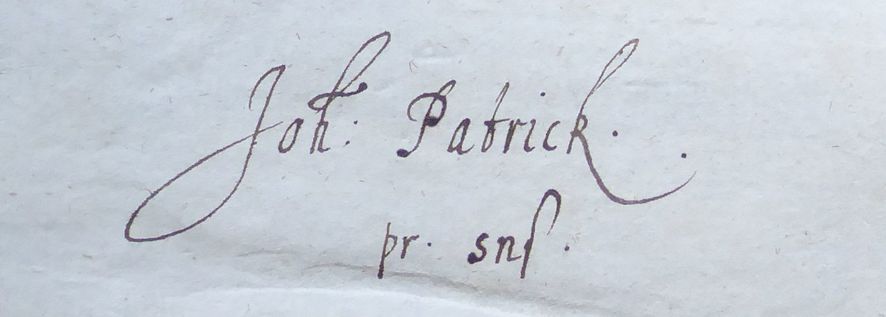Difference between revisions of "John Patrick 1632-1695"
(→Characteristic markings: image code tweaked) |
(Un-suppressed the file page link in the image code) |
||
| Line 8: | Line 8: | ||
====Characteristic markings==== | ====Characteristic markings==== | ||
| − | [[File:Joh-patrick.jpg| thumb| 886px | + | [[File:Joh-patrick.jpg| thumb| 886px | Book inscription by John Patrick]] |
Patrick typically inscribed his titlepages with his name, and a private code showing the price paid; some books also carry a number suggesting he had a sequential classification or shelving system. Some of his books are annotated through the text and on the flyleaves, marking passages of interest. | Patrick typically inscribed his titlepages with his name, and a private code showing the price paid; some books also carry a number suggesting he had a sequential classification or shelving system. Some of his books are annotated through the text and on the flyleaves, marking passages of interest. | ||
Revision as of 01:51, 11 February 2020
John PATRICK 1632-1695
Biographical Note
Born at Gainsborough, Lincolnshire, son of Henry Patrick, mercer; younger brother of Simon Patrick, later Bishop of Ely. BA Queens’ College, Cambridge 1651, MA 1654. He acted as his brother’s curate as vicar of Battersea from 1662, until installed as preacher of Charterhouse in 1671. He remained there for the rest of his career, gaining recognition as an author of theological and expository works which defended the viewpoint of the established Church of England.
Books
Patrick bequeathed all his books (along with the residue of his estate more generally) to his brother Simon, who estimated that the library had cost him over £1000 to assemble. Most of these passed soon afterwards into the cathedral libraries of Peterborough and Ely. Examples: British Library 877.1.4, 785.d.4; Cambridge University Library Peterborough C.11.1, A.5.1, Ely.c.283, Ely.b.44.
Characteristic markings
Patrick typically inscribed his titlepages with his name, and a private code showing the price paid; some books also carry a number suggesting he had a sequential classification or shelving system. Some of his books are annotated through the text and on the flyleaves, marking passages of interest.
Sources
- Handley, Stuart. '"Patrick, John (bap. 1632, d. 1695), Church of England clergyman and religious controversialist."' Oxford Dictionary of National Biography.
